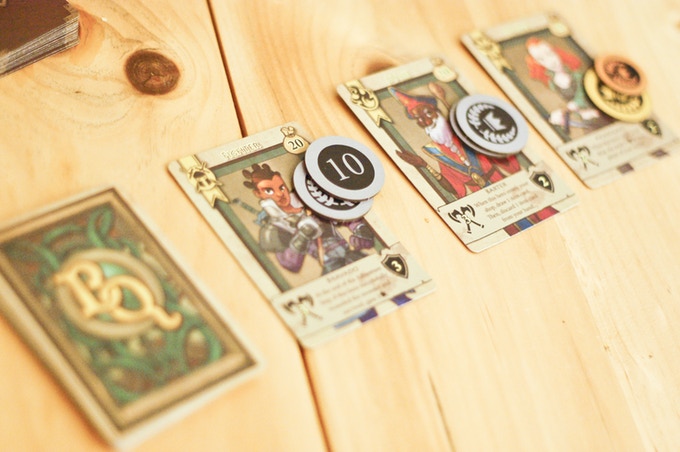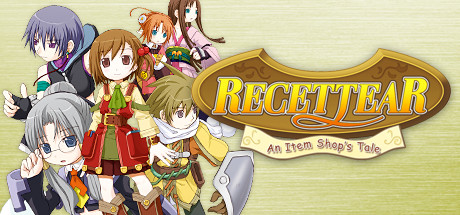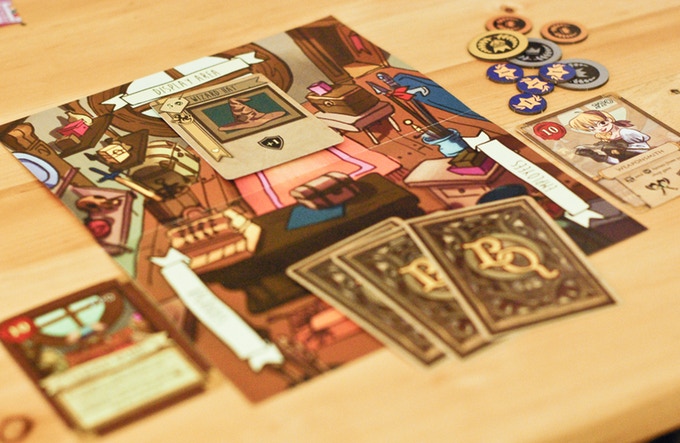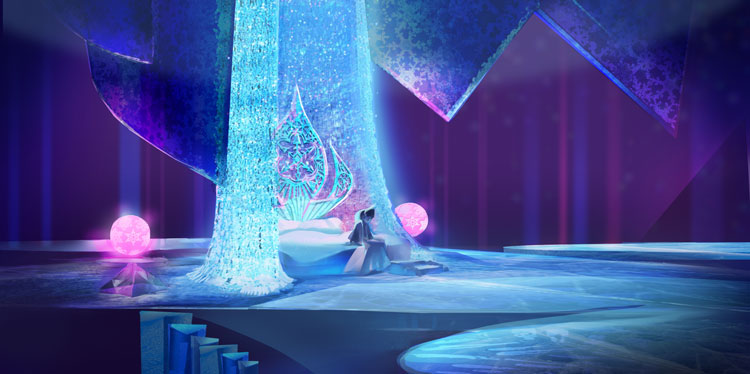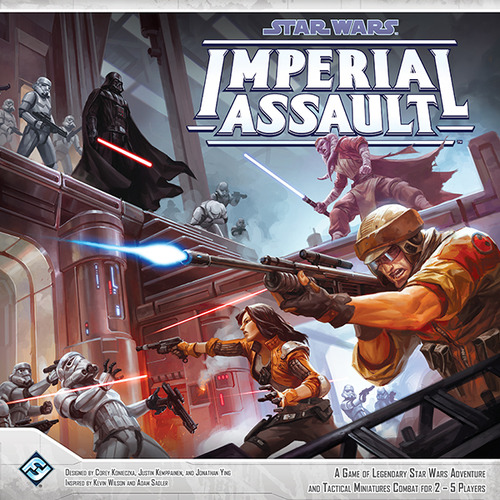As part of our December Spotlight on Bargain Quest, we strive to inform readers of little extra tidbits surrounding the game. Games are made by people, and one of those tidbits we enjoy is learning a little bit more about the people behind them. Some designers shy away from the public stage, while others enjoy being front and center.
In the case of Bargain Quest, it’s admittedly a mix of both for designer Jonathan Ying. Although Bargain Quest would be his first independently produced game, Jonathan is not new to the design world, with a handful of recognizable game titles to his name. As he came to find out, however, the experience of having to nurture it from concept to fulfillment was a lot like running one of the shops within the game. Which, if you think about it, is what a crowdfunding project really is: a tiny, short-term business operation. The difference being instead of worrying about rampaging dragons and running out of health potions to sell to passing do-gooders wandering into your shop you have to deal with overseas shipping manifests and project development timetables. And that’s a lot less interesting.
Look, there’s a reason escapism is such a popular pastime…
Because of that, Jonathan has had his plate rather full these days on the final and most rewarding part of creating a new game: getting those games into people’s hands. So while it’s evident from our short conversation with him that there’s both a passion behind his latest creation and a desire to chat at length about it, finalizing its delivery has also been keeping him pretty busy.
Thankfully you don’t have to take our word for it, as we did manage to grab him during a brief reprieve to chat about what makes Bargain Quest so appealing to him. And to us. Enjoy!
Round One Questions
CR: What was your Gateway Game?
I played a few games very casually as a kid such as Magic the Gathering, Yu-Gi-Oh, and Heroclix, but I think it wasn’t until Dungeons & Dragons and Dominion that I started really taking tabletop games seriously as a hobby. From there Cosmic Encounter is what piqued my interest in examining game design, as simple basic mechanics that were dramatically augmented by the Alien abilities were really quite exciting for me.
CR: What was the last game you really enjoyed playing (besides Bargain Quest)?
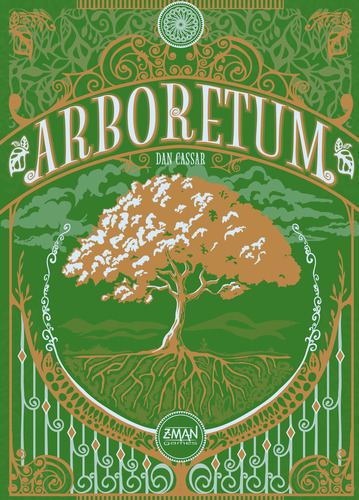 It took a very long time, but I finally got my hands on a copy of Arboretum and have been really enjoying that experience. I have a habit of designing really thematic games so I’m super impressed whenever a design comes out that manages to craft an incredible puzzle with just colors and numbers.
It took a very long time, but I finally got my hands on a copy of Arboretum and have been really enjoying that experience. I have a habit of designing really thematic games so I’m super impressed whenever a design comes out that manages to craft an incredible puzzle with just colors and numbers.
CR: How big is your game collection?
Haha, probably too big at this point! I’ve easily got 200 games kicking around in my apartment. I’ve been trying to keep a system where if I ever want to pick up something new I have to get rid of an older one I haven’t played much.
CR: What is your favorite type of game to play?
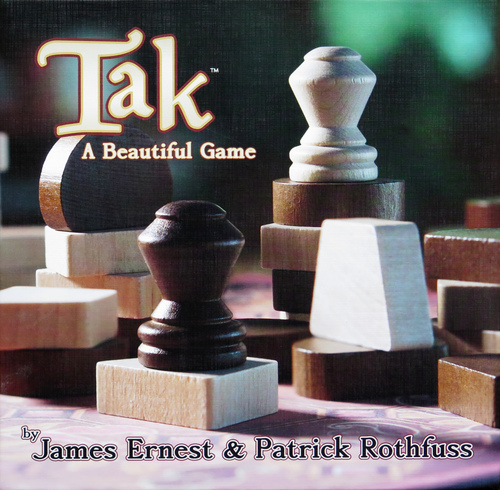
As opposite as it comes
It varies a lot. I play a lot of games for research so generally when I want to have fun I’m gonna pick a game that’s not in the genre I’m currently designing for. So for example, while doing big heavy titles like Imperial Assault my favorite games were silly ones like Loopin’ Louie and Click Clack Lumberjack, whereas during Bargain Quest I was super into abstract games like Tak and Push Fight.
CR: How do you feel about Monopoly?
It’s certainly got a fascinating history. My understanding is that Elizabeth Magie designed it to be a demonstration of the dangers of capitalist markets, and in that respect I’d say it succeeded and, somewhat worryingly, continues to succeed.
On Bargain Quest
CR: Bargain Quest is the latest in an (albeit small) list of games that looks at the adventuring party motif from a different angle than simply being the heroes saving the town. Have you played any other games that do something in a similar way?
I suppose the most obvious comparisons are the games that originated the concept: Boss Monster, a game where players control the bosses and the dungeons rather than the heroes, and of course the single player PC game Recettear about a young girl who inherits an item shop, were both huge inspirations for the way the game works. Games like Darkest Dungeon and Torchbearer are super interesting examinations of the psychological ramifications of dungeon delving which I also quite enjoy.
CR: The idea of playing as the shopkeepers in a town under siege is both amusing and playfully subversive. How did the concept come about?
Recettear probably planted the seed of the idea in my head way back, but really this is a game that started off with a simple mechanic where you’d have items that had multiple competing values, so an item that would look awesome in your window but you’d also want to sell. That, combined with my inherent fascination with the mundane lives of fantasy characters, came together to make the game what it was.
CR: We’ve also thought many times about the lives of merchants, farmers, and other NPCs in countess stories, from what it’d be like to be Sherlock Holmes’ neighbor to what kind of market there is for Chocobo meat. (Is it not edible or just taboo?) What is it about that line of thought that particularly appeals to you?
I think philosophically I’m often a little uncomfortable with Heroes Journey narratives because they really imply a sort of fundamental importance to the protagonists that worries me. I really love to celebrate the smaller struggles of the regular folk. I loved the novel Death Star about the lives of a bunch of characters who just lived and worked on the Death Star before it was destroyed. Terry Pratchett’s City Watch stories are also fantastic.
CR: To a similar end, were there areas of Bargain Quest that you wanted to explore but had to cut out for mechanical or complexity reasons, or was it close to what we see in the final version?
The heroes originally had a much more complex system for deciding what shop they would enter, but it became just a bit too fiddly to really work. The process of acquiring your goods from suppliers was also toyed with but proved to just distract from the core of the game; that is, managing your shop.
CR: You’ve stated elsewhere about the quality of the game’s artwork. How important was that to the development of getting Bargain Quest where you wanted it to be?
So our illustrator was my sister, Victoria Ying. She’s a former Disney Visual Development artist, and she’s done a lot of work for kids books as well. We’ve collaborated on projects before, though never on a game. We went back and forth on a lot of designs, and in particular we wanted to put a huge emphasis on diversity and inclusion in the game’s art. We worked very hard to make sure that the game wasn’t just your usual generic Tolkeinesque fantasy. Vicky is incredibly skilled and was very, very patient with me when it came to revisions, so I count myself really lucky to have her work in the game.
CR: You’ve developed a handful of other games such as Imperial Assault and Doom, but this was your first independent Kickstarter. What was that transition like?
It was kind of intense honestly. I had the benefit of some excellent advice and mentorship from George Rohac and Tim Fowers who guided me through some of the thornier patches. Having to do everything from graphic design to KS promotion was exhausting, though I did enjoy having total creative control, which is also an advantage of not having to work within a license.
CR: We’re sure you didn’t have to fight monsters, but making games can still be hard. What would you say was the biggest challenge you experienced getting Bargain Quest successfully published?
Working on logistics was pretty much the most challenging thing I’d ever done. Back at FFG [Fantasy Flight Games] I could just tunnel-vision onto design and not really worry about other things since I knew other people had it covered. Plus I had a hard-schedule set by management I could refer to if I wanted to know if I was on track. With Bargain Quest I had to do all that stuff myself, and I admit it’s not something I’m normally predisposed to. Still, I suppose it all worked out in the end. I’ve really learned a lot!
CR: Finally, tell us: what kinds of items would someone have to put in a shop window to lure you in? We promise we’re not setting up any traps…maybe…
I’m definitely a sucker for art books – animation, comics, video games – doesn’t matter I will buy the art book. That, and pretty much any Godzilla paraphernalia (Heisei Era preferred).
Bargain Quest is a lightweight card drafting game about selling your armor and weapons to passing heroes, and your goal ultimately is to sell as much of that stuff as possible for the most money. The fact that some of those heroes may not, well, survive, is a bit immaterial. Just like there will always be goblins, there’s always going to be someone to rise up and attempt to thwart them. And if you play your cards right, you’ll be there to sell your goods to that person too!
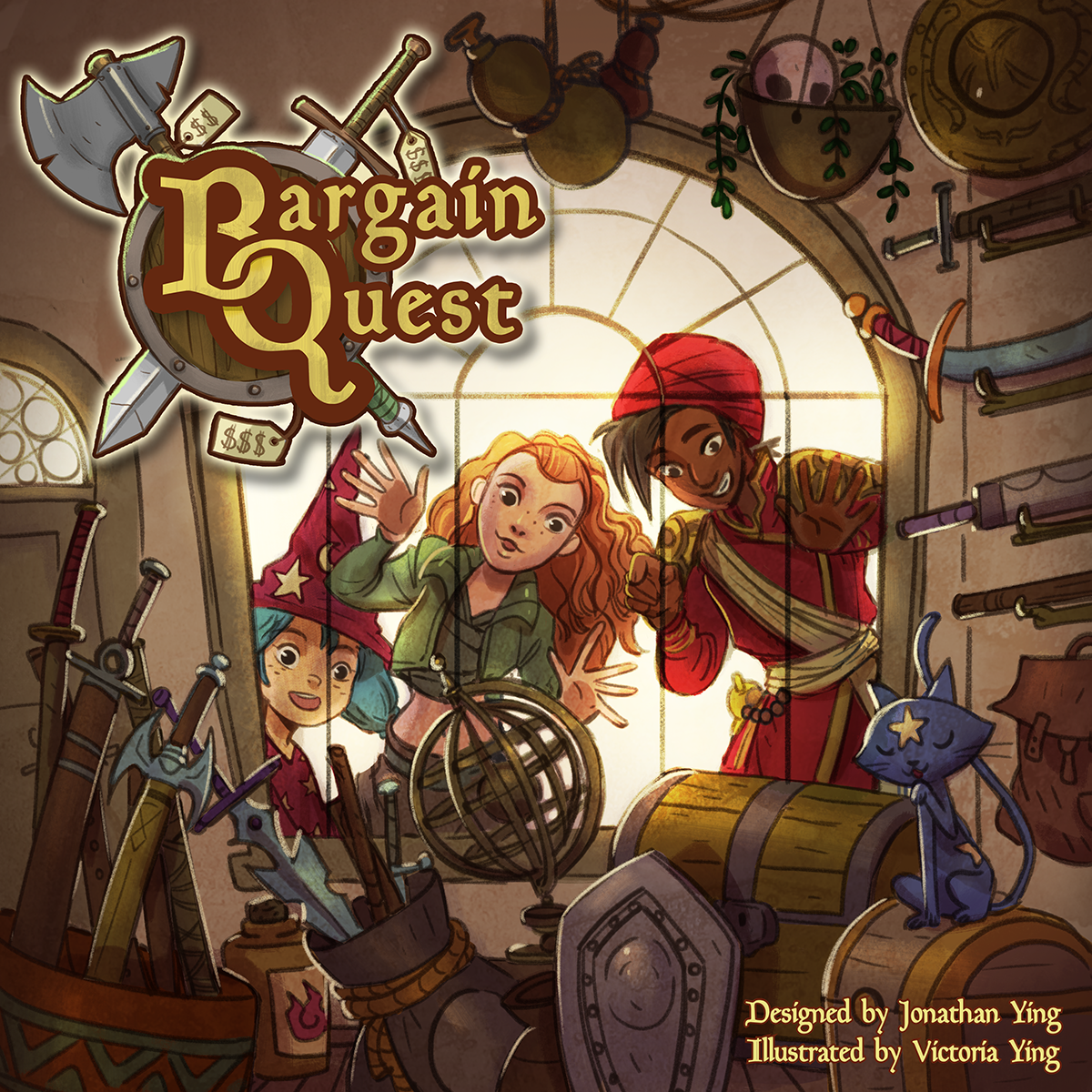
Of course, running any business, even one as fickle as catering to the hero kinds, can be tricky. You don’t want to scare your customers off – before they’ve paid at least – and you want to ensure that you’re able to properly invest your income into making upgrades and hiring additional help. But rather than taking the big risk of opening a shop, why not take an opportunity to test your hawking acumen from the comfort of your own home first? Not only is that possible – we’re ready to help with that with a little giveaway:
Photo Credits: Bargain Quest cover and photos by Jonathan Ying; Recettear logo by Carpe Fulgur; Concept art by Victoria Ying.

